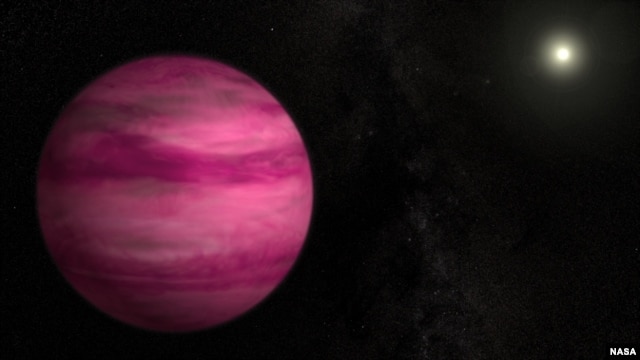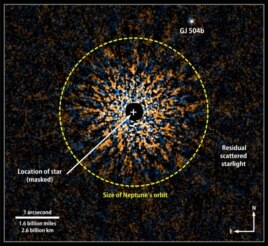News / Science & Technology
New Exoplanet Spotted with Earth-based Telescope
Glowing a dark magenta, the newly discovered exoplanet GJ 504b weighs in with about four times Jupiter's mass, making it the lowest-mass planet ever directly imaged around a star like the sun. Image Credit: S. Wiessinger
Astronomers have discovered a new exoplanet orbiting a sun-like star 57 light years away. The exoplanet is four times the size of Jupiter and can actually be seen by Earth-based telescopes.
The planet, named GJ 504b, is the lowest mass exoplanet ever to be detected using direct, or visible, imaging techniques. Most exoplanets – planets outside our solar system -- are discovered using indirect methods in which the exoplanet’s existence is inferred, but not actually seen.
GJ 504b’s sun is slightly hotter than our sun and is visible to the naked eye in the constellation Virgo. The planet was spotted by the Subaru Telescope in Hawaii.
"If we could travel to this giant planet, we would see a world still glowing from the heat of its formation with a color reminiscent of a dark cherry blossom, a dull magenta," said Michael McElwain, a member of the discovery team at NASA's Goddard Space Flight Center in Greenbelt, Md. in a statement. "Our near-infrared camera reveals that its color is much more blue than other imaged planets, which may indicate that its atmosphere has fewer clouds."
Direct imaging is the most challenging method to spot exoplanets, explained Masayuki Kuzuhara at the Tokyo Institute of Technology, who led the discovery team.
"Imaging provides information about the planet’s luminosity, temperature, atmosphere and orbit, but because planets are so faint and so close to their host stars, it's like trying to take a picture of a firefly near a searchlight," he said.
However, since the GJ504 star system is relatively young – an estimated 160 million years old – that GJ 504b has not had long enough to lose the heat of its formation, which enhances infrared brightness.
"Our sun is about halfway through its energy-producing life, but GJ504 is only one-thirtieth its age," added McElwain. "Studying these systems is a little like seeing our own planetary system in its youth."
Additionally, GJ 504b orbits its star at roughly nine times the distance Jupiter orbits the sun, which challenges the most widely held theory about how planets form. That theory poses that planets similar to Jupiter form from in inside gas-rich debris disks that surround young stars. Collisions among asteroids and comets create a core, and when the mass of the core gets large enough, its gravity attracts gas and debris from the disk.
The model works for planets as far away from our sun as Neptune, but for GJ 504b, which is so far away from its star, the model becomes “problematic.”
"This is among the hardest planets to explain in a traditional planet-formation framework," explained team member Markus Janson, a Hubble post-doctoral fellow at Princeton University in New Jersey. "Its discovery implies that we need to seriously consider alternative formation theories, or perhaps to reassess some of the basic assumptions in the core-accretion theory."
A paper describing the results has been accepted for publication in The Astrophysical Journal and will appear in a future issue
The planet, named GJ 504b, is the lowest mass exoplanet ever to be detected using direct, or visible, imaging techniques. Most exoplanets – planets outside our solar system -- are discovered using indirect methods in which the exoplanet’s existence is inferred, but not actually seen.
GJ 504b’s sun is slightly hotter than our sun and is visible to the naked eye in the constellation Virgo. The planet was spotted by the Subaru Telescope in Hawaii.
"If we could travel to this giant planet, we would see a world still glowing from the heat of its formation with a color reminiscent of a dark cherry blossom, a dull magenta," said Michael McElwain, a member of the discovery team at NASA's Goddard Space Flight Center in Greenbelt, Md. in a statement. "Our near-infrared camera reveals that its color is much more blue than other imaged planets, which may indicate that its atmosphere has fewer clouds."
Direct imaging is the most challenging method to spot exoplanets, explained Masayuki Kuzuhara at the Tokyo Institute of Technology, who led the discovery team.
"Imaging provides information about the planet’s luminosity, temperature, atmosphere and orbit, but because planets are so faint and so close to their host stars, it's like trying to take a picture of a firefly near a searchlight," he said.
However, since the GJ504 star system is relatively young – an estimated 160 million years old – that GJ 504b has not had long enough to lose the heat of its formation, which enhances infrared brightness.
"Our sun is about halfway through its energy-producing life, but GJ504 is only one-thirtieth its age," added McElwain. "Studying these systems is a little like seeing our own planetary system in its youth."
Additionally, GJ 504b orbits its star at roughly nine times the distance Jupiter orbits the sun, which challenges the most widely held theory about how planets form. That theory poses that planets similar to Jupiter form from in inside gas-rich debris disks that surround young stars. Collisions among asteroids and comets create a core, and when the mass of the core gets large enough, its gravity attracts gas and debris from the disk.
The model works for planets as far away from our sun as Neptune, but for GJ 504b, which is so far away from its star, the model becomes “problematic.”
"This is among the hardest planets to explain in a traditional planet-formation framework," explained team member Markus Janson, a Hubble post-doctoral fellow at Princeton University in New Jersey. "Its discovery implies that we need to seriously consider alternative formation theories, or perhaps to reassess some of the basic assumptions in the core-accretion theory."
A paper describing the results has been accepted for publication in The Astrophysical Journal and will appear in a future issue







No comments:
Post a Comment